
Lluís Domènech i Montaner was a Catalan architect who was very much involved in and influential for the Catalan Modernisme català, the Art Nouveau/Jugendstil movement. He was also a Catalan politician.

Cocentaina is a locality and municipality in the comarca of Comtat, in the province of Alicante, Spain. The village is located between the mountainous Serra de Mariola national park and the Serpis river. Cocentaina is ideally situated for both road and mountain biking. Many of the roads are used for training by professional teams, and several roads have been used by the Vuelta a España.

Antonio Palacios Ramilo was a Spanish architect. Distinguished by the monumental eclecticism he left as imprint in many of his projects, he helped define the architectural identity of Madrid in the first half of the 20th century.
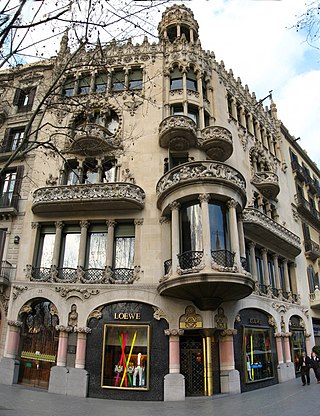
The Casa Lleó Morera is a building designed by noted modernisme architect Lluís Domènech i Montaner, located at Passeig de Gràcia 35 in the Eixample district of Barcelona. In 1902 Francesca Morera assigned Lluís Domènech i Montaner to remodel ancient "casa Rocamora", built in 1864. She died in 1904, and the building was named after her son, Albert Lleó i Morera. The building is located on the corner of Carrer del Consell de Cent, and is one of the three important buildings of Barcelona's Illa de la Discòrdia, and it is the only building of the block awarded Barcelona's town council's Arts Building Annual Award, obtained in 1906. The building lost some of its most representative elements, such as the tempietto on its top and the ground floor and mezzanine's architectural sculpture. The building is also known as the residence of Cuban-Catalan photographer Pau Audouard.
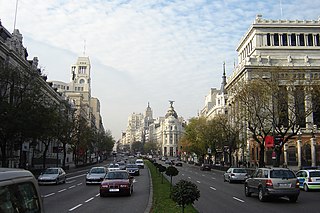
Calle de Alcalá is among the longest streets in Madrid. It starts at the Puerta del Sol and goes on for 11 kilometres (6.8 mi), to the northeastern outskirts of the city. Henry David Inglis described it in 1837 as "long, of superb width, and flanked by a splendid range of unequal buildings".

Alcoy is an industrial and university city, region and municipality located in the Valencian Community, Spain. The Serpis river crosses the municipal boundary of Alcoy. The local authority reported a population of 61,135 residents in 2018.
Timoteo Briet Montaud was a Spanish architect, one of the main architects of the Art Nouveau in Alcoy and the Valencian Art Nouveau.

Vicente Juan Pascual Pastor was a spanish architect, one of the main architects of the Art Nouveau in Alcoy and the Valencian Art Nouveau.

Valencian Art Nouveau, is the historiographic denomination given to an art and literature movement associated with the Art Nouveau in the Valencian Community, in Spain.

The Casa del Pavo is a private building at 15 Sant Nicolau Street, in the city center of Alcoy (Alicante), Valencian Community, Spain. It is one of the main works of the Art Nouveau in Alcoy.

The Circulo Industrial de Alcoy(Alcoy's Industrial Circle) is a cultural institution from Alcoy (Alicante), Valencian Community, Spain, founded on January 1, 1868. It is placed at 19 Sant Nicolau street, in the city center of Alcoy.

The Casa Laporta(Laporta house) is a private building at 26 País Valencià avenue, in the city center of Alcoy (Alicante), Valencian Community, Spain. It is one of the main works of the Art Nouveau in Alcoy.

The Casa d'Escaló(Escaló house) is a public building at 2 Joan Cantó street, in the city center of Alcoy (Alicante), Valencian Community, Spain. It is one of the main works of the Art Nouveau in Alcoy.
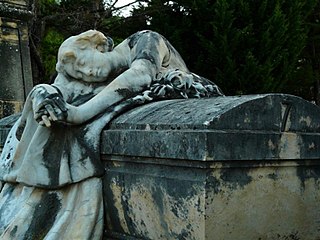
The Cementerio de San Antonio Abad(transl. Saint Anthony Cemetery) or Cementeri d'Alcoi is a cemetery located in Alcoy (Alicante), Spain.
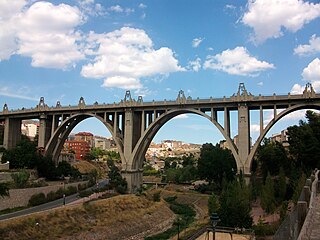
The San Jorge Bridge, is a bridge located in Alcoy (Alicante), Valencian Community, Spain, crossing the Serpis River.
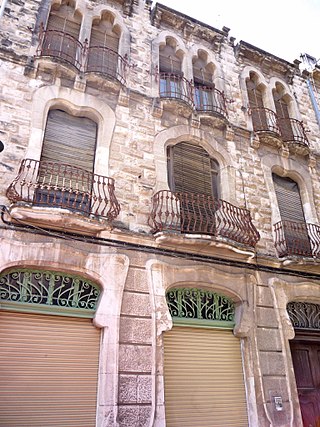
The Casa Vilaplana(Vilaplana house) is a private building at 8 Joan Cantó street in the city center of Alcoy (Alicante), Valencian Community, Spain.

The Casa Briet(Briet house) is a private building at 24 Sant Josep Street, in the city center of Alcoy (Alicante), Valencian Community, Spain.
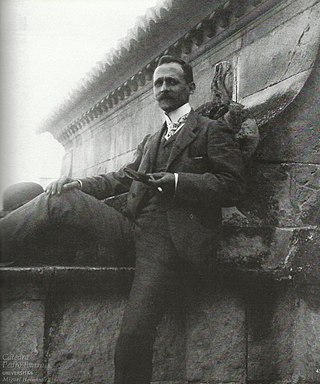
Marcel·lià Coquillat i Llofriu was a Spanish architect of the Modernisme and Noucentisme movements.

Fernando Cabrera Cantó (1866–1937) was a Spanish painter and sculptor; whose themes ranged from the cheerful and satiric to the darkly morbid. He also did landscapes.
Art Nouveau in Madrid is the historiographic term given to the artistic style Art Nouveau as it developed in and around Madrid, the capital of Spain, around 1900, permeating architecture, design, the decorative arts, graphic arts, and broader culture. There is also a “Modernismo madrileño” in the field of literature, likewise situated in the capital and considered to be the nucleus of the origins of the modern movement of Spanish literature.
































